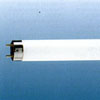
Defining the luminance
| symbol | L | unit | cd/m² |
The luminance is defined as the luminous intensity of a surface in a specifi c direction, divided by the projected area as viewed from that direction. Unless the object is perfectly diffusing, the luminance will vary, depending on the reflective characteristics of the material.

Defining the luminance
This definition implies that the object emits light. It does not, however, need to be a lamp. Every object can be an emitter just by reflecting light, in which case it is a secondary light source, or by transmitting it.
The concept of the luminance is to get a quantitative idea about the 'brightness' of a light source. Two objects that have the same luminous intensity into a certain direction will always produce the same illuminance at the same distance. The problem is thoug h that the luminous intensity doesn't tell us how 'bright' the light source is. A small but bright source can produce the same illuminance on an object as a large but dim one would. The intensity can therefore not fully describe the characteristics of an emitter. So how bright is bright?
It is the luminance that gives the answer. It normalises the intesity to the area. Taking the two objects with identical intensities again, then the bigger one will have a lower luminance than the smaller one. Or, to put it the other way, the luminous intensity is the product of luminance times projected area of the light source.
The luminance of an object is not the same as the perceived brightness.
|
|
|
|
|
|

|
 |
 |
 |
 |
|
|
|
|
|
|
Luminances of some common objects (in cd/m²)
(Fluorescent tube courtesy of Philips Lighting)